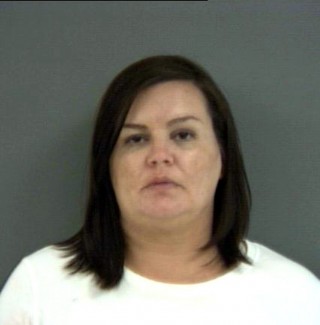
By Michael Graczyk
Associated Press
LUFKIN — An East Texas nurse violated the trust of a noble profession when she injected kidney dialysis patients with toxic bleach, killing five of them and injuring five others, a prosecutor said as the woman’s murder trial began Monday.
Kimberly Saenz, 38, faces a possible death sentence if convicted of capital murder in the April 2008 deaths.
Saenz stood in court holding her hands behind her back as Angelina County District Attorney Clyde Herrington read the six-count indictment against her.
Her lawyer, Ryan Deaton, answered “Not guilty, your honor,” on her behalf when the judge asked for a plea after each count.
Herrington told jurors in his opening remarks that evidence would show there was bleach in the IV dialysis lines of victims who were being treated at a DaVita dialysis clinic in Lufkin, about 125 miles northeast of Houston.
“The defendant in this case is the one that put it there,” he said.
He said investigators also found Internet searches on Saenz’s computer about bleach poisoning in blood and whether bleach could be detected in dialysis lines.
“The profession of nursing is one of the most respected,” Herrington told jurors. “Health care providers devote their career to those who are sick and ill … But involves a great deal of trust. And if that trust is violated, very serious things can happen.”
Saenz was charged a year after the Lufkin clinic closed for about two months following a rash of illnesses and deaths.
Emergency crews had been called to the clinic many as 30 times that April, including seven for cardiac problems, and made at least 19 runs. Four people had died.
There had been only two calls during the previous 15 months, according to the Texas Department of Health Services.
Denver-based health care giant DaVita Inc. investigated along with local, state and federal agencies.
Inspectors were present on April 28, 2008, when two dialysis patients said they suddenly didn’t feel well and two others reported that they saw Saenz inject bleach into tubing used by two fellow patients.
Saenz, who had held her entry-level position as a licensed vocational nurse for eight months, was sent home. Police were summoned. The next day she was fired.
In his opening defense statement, Deaton said the stories told by the two patients who complained about Saenz varied widely and said DaVita officials waited eight hours before calling police.
“DaVita Inc. is the puppet master in this case,” he said, drawing an immediate objection from Herrington that was upheld by the judge.
But he continued to blame the company, insisting DaVita “has manipulated the evidence … and the science in this case.”
Deaton said he would present evidence to contradict the charges.
For example, a syringe patients saw Saenz using was being used to measure bleach for a cleaning solution so Saenz could get the precise amount and adhere to clinic rules, he said.
“When Kim supposedly is doing this, there’s a monitor watching her, there’s people in the clinic,” Deaton said. “Patients are watching what’s going on.”
“Everybody’s freaking out,” he continued. “People were dying. Everybody’s on edge. This whole thing is just a firecracker.”
Federal investigators examined blood tubing, IV bags and syringes used by the DaVita patients, who spent up to three days a week tethered for hours to a machine that filtered their blood — a job their kidneys could no longer do.
Joel Sprott, an attorney for clinic operator DaVita Inc., has said the Denver-based company turned over more than 10,000 pages of records in the case.
Through 2011, DaVita operated or provided services to 1,809 dialysis facilities in the U.S., serving some 142,000 patients and employing more than 41,000 people.
Citing a gag order imposed by the judge, DaVita spokesman Vince Hancock would only say last week only that the company looks forward “to continuing our steadfast commitment to the Lufkin community.”
A Food and Drug Administration report found some samples linked to some victims tested positive for bleach while others showed bleach “may have been present at one time.”
Clinic policy calls for bleach to be used in various concentrations for cleaning and then chemical reactive agents are used to confirm bleach residue was removed and the cleaned areas are safe. “The point is, bleach is used in every aspect of dialysis,” Deaton said.



